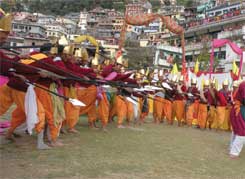 For Dr Data Ram Purohit, Uttarakhand is not only a place of scenic beauty and peace. It is also a treasuretrove of art and culture, which he has every intention to not only resurrect, restore but also help propagate
For Dr Data Ram Purohit, Uttarakhand is not only a place of scenic beauty and peace. It is also a treasuretrove of art and culture, which he has every intention to not only resurrect, restore but also help propagate
Synonymous with Garhwali folklore and tradition, is a humble, hard-working and focused person known to me as Dr Data Ram Purohit. Born on August 8, 1953, in the quaint hill village of Queeli in Rudraprayag district of Uttarakhand, Purohit sir, as I fondly call him, has come a long way since.
One amongst six siblings, Purohit was drawn to the bounty of nature bestowed upon his surroundings — the Himalayas made for spectacular background, and the constant roar of the mighty Alaknanda River was a sound he grew up with. With none of the present-day gadgets to amuse or distract young minds, Purohit, like most of his peer group people, found entertainment outdoors. But how did he stumble upon the world of theatre? I ask. “I must have been 13 that year. En route to my elder sister’s home one evening, I found the director of the nearby Ram Lila frantically looking for someone to enact the role of Lakshman,” he recalls. The Ram Lila theatre at the Chopra village, about three km from Queeli, was a must-see annual event that everyone looked forward to.
Purohit adds how he jumped at the opportunity, for he was quite well-known for his singing and dialogue-delivery skills. Left with little choice, the director decided to risk it,” he says, with a smile, “That was my debut role — the role of Lakshman at Chopra village Ram Lila theatre. My performance that evening became the talk of the town and also served as a steppingstone into the world of Garhwali folklore and theatre.”
As if under a spell, Purohit set about putting together a drama club in Queeli, where not only did he act, but also directed and produced over half-a-dozen dramas, especially during Diwali. He reminisces how, after a hard day’s work in the fields and grazing the cattle, the autumn evenings were something he looked forward to. “The drudgery of the day’s work was forgotten when I stepped on to the stage to play my part.”
While Purohit went about finishing his formal education, his love and interest for local art and culture stayed with him. His first job was that of a postal clerk in the post and telecom department at Gopeshwar, Uttarakhand, even as he pursued his post-graduate degree in English. In 1979, he was appointed assistant professor in the English faculty of the Hemvati Nandan Bahuguna University, Shrinagar. He also went on to get his MPhil and doctorate in the subject.
I wonder aloud if he can choose his greatest achievement amongst the many. Quick comes the reply, “The Centre for Folk Performing Arts and Culture in H.N.B. Garhwal University, which was set up in 2006, would be one of my greatest accomplishments. The fact that this is a one-of-its-kind centre that boasts of documenting, packaging and digitalising the artistic and cultural traditions, as well as their repositories belonging to the Central Himalaya region, makes me proud.”
Purohit also takes time off to pursue his first love, art and theatre. The founding member of Shailnat and Vidyadhar SRICALA theatre groups in Shrinagar, he has also carried out a number of research projects on the Mahabharata traditions of Garhwal. Recorded history at the Centre shows that the Mahabharata from the hills has about 16 ritual variants, including the Mahabharata of Kedar Valley. Other than this, he has painstakingly carried out elaborate research work on the vanishing Pandava dances held in over 500 villages spread across the Garhwal region.
One with a tireless quest for exploring art and culture over the years, Purohit has also been involved in propagating and reviving various dance forms and theatre groups from the brink of total extinction. Mask dance dramas, Beda theatre, Holi theatre, Bagdwali theatre, Hiljaatra theatre, Ramlila theatre, Holi singing, Nanda Devi Raj Jat, Mahasu, circular dances, dhol music, Nain theatre and narrative theatre, to name a few, are some of the rare art forms that he has done tremendous work on.
When I got a chance to pin him down for an interview for Democratic World, this busy man had just returned home from a one-day recce to Guptkashi, assisting world-acclaimed Serbian film director Goran Paskaljevi. Purohit and Paskaljević had been immersed in a two-day brainstorming session, discussing Garhwali locale, art, literature, theatre, music and folklore for a movie based entirely on Garhwal and its rich heritage. And who better to assist this great movie maker, I wonder, than the best that these hills will ever have to offer — a thesaurus of Garhwal’s rich art, theatre and culture.
